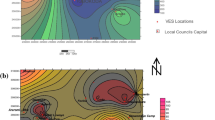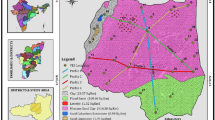Abstract
A combined geophysical investigation consisting of vertical electrical sounding (VES) and multielectrode system was carried out to map the subsurface resistivity in all major lakes which are highly polluted by the discharge of sewage and other chemical effluents in greater Hyderabad, India. The structural features identified in the study area play a major role in groundwater flow and storage. The interpretation of geophysical data and lithologs indicates that a silt/clay zone (predominantly silt) has a thickness of 5–10 m all along the drainage from Patelcheruvu to the Musi River. The silt/clay zone inferred close to the lakes is a mixture of clay, silt and sand with more silt content as indicated from the lithologs during drilling. The low resistivity values obtained can be attributed to the pollutant accumulated in the silt which can reduce the resistivity values. Further, the TDS of the water samples in these wells are more than 1,000 mg/l which further confirms the above scenario. The pollution spread is less in the upstream areas whereas it is more in the downstream which can be attributed to the shallow water table conditions and also due to the interaction of surface water and groundwater.














Similar content being viewed by others
References
Balakrishna S (1961) Granite tectonics of Hyderabad. Proc Indian Acad Sci 43:73–84
Balakrishna S (1964) Some studies on granites of Hyderabad. In: Proceedings of seminar on peninsular geology, pp 232–253
Barker R (1981) The offset system of electrical resistivity sounding and its use with a multicore cable. Geophys Prospect 29:128–143
Battacharya PK, Patra HP (1968) Direct current electrical sounding. Elsevier, Amsterdam
Crawford AR (1969) Reconnaissance Rb–Sr dating of the Precambrian rocks of southern Peninsular India. J Geol Soc Ind Vol 10(2):117–166
Divakara Rao V (1974) Origin of Peninsular Granites. Geophys Res Bull 12(2):3
Dobrin MB (1976) Introduction to geophysical prospecting, 3rd edn. McGraw Hill, New York
Ebraheem AM, Hamburger MW, Bayless ER, Krothe NC (1990) A Study Of acid mine drainage using earth resistivity measurements. Ground Water 28(3):361–386
Ebraheem AM, Senosy MM, Dahab KA (1996) Geoelectrical and hydrochemical studies for delineating groundwater contamination due to salt water intrusion in the Northern part of Nile Delta. Egypt. Ground Water 35(2):216–222
Gnaneshwar P (1987) Litho-geochemical surveys in Hyderabad granites, Ph.D. Thesis (Unpublished). Osmania University, Hyderabad
Grant FS, West GF (1965) Interpretation theory in applied geophysics. McGraw Hill, New York
Griffiths DH, Turnbull J, Olayinka AI (1990) Two dimensional resistivity mapping with a computer controlled array. First Break 8:121–129
Griffiths DH, Barker RD (1993) Two dimensional imaging modeling in areas of complex geology. J Appl Geophys 20:211–226
Guptasarma D (1982) Optimization of short digital linear filters for increased accuracy. Geophys Prospect 30:501–514
Janardhan Rao Y (1963) The pink and grey granites of Hyderabad and the problem of their age relationship. In: Proceedings of symposium on stratigraphy, age and correlation of the Archaean provinces of India
Janardhan Rao Y (1965) The origin of Hyderabad granites—a new interpretation. J. Indian Geosci Assoc 5:111–118
Jupp DLB, Vozoff K (1975) Stable iterative methods for the inversion of geophysical data. Geophys J Roy Astron Soc 42:957–976
Keller GV, Frischnecht FC (1966) Electrical methods in geophysical prospecting. Pergamon Press, New York
Kelly WE (1976) Geoelectric sounding for delineating groundwater contamination. Ground Water 14:P6–P10
Koefoed O (1979) Geosounding principles. Elsevier, Amsterdam
Krishnan MS (1960) Precambrian stratigraphy of India. Report 21st International Geol. Cong. Norden part 9, pp 95–107
Loke MH, Barker RD (1996a) Rapid least squares inversion of apparent resistivity pseudosections by a quasi Newton method. Geophys Prospect 44:131–152
Loke MH, Barker RD (1996b) Practical techniques for 3D resistivity surveys and data inversion. Geophys Prospect 44:499–523
Mahadevan TM (1995) Deep continental crust of India. Geol. Surv India Memoirs 27
Mazac O, Kelly WE, Landa I (1987) Surface geoelectrics for groundwater pollution and protection studies. J Hydrol 93:277–294
Orellana E, Mooney HM (1966) Master tables and curves for vertical electrical sounding over layered structures. Interientia, Madrid
Pal PC, Khurana KK, Unnikrishnan P (1978) Two examples of spectral approach to source depth estimation in gravity and magnetics. Pure Appl Geophys 117:772–783
Parasnis DS (1973) Pronciples of applied geophysics, 5th edn. Chapman and Hall, London
Parkhomenko EI (1967) Electrical properties of rocks. In: Keller GV (ed) Plenum Press, New York (translated from Russian)
Pichamuthu CS (1967) The Precambrian of India. In: Rankama K (ed) The Precambrian. Wiley, New York
Radhakrishna BP, Naqvi SM (1986) Precambrian Continental Crust of India and its evolution. J Geol 94:145–166
Rai SS, Rajagopal Sarma PVSS, Prakasam KS, Rao VK (1996) Seismic evidence for thick and underplated late Archaean crust of eastern Dharwar craton. Proc Ind Acad Sci (Earth Planet Sci) 105(4):431–439
Raja N (1959) Pegmatites from Uppal (Hyderabad). Curr Sci 28:284–285
Raja N, Sarma SR (1958) Some observations on the pyroxene Granites of Hyderabad (India). Science de Laterr 5:245–254
Sankaran S (2007) Environmental impact assessment of selected lakes in greater Hyderabad, Andhra Pradesh. Ph.D thesis submitted to Osmania University, India
Sankaran S, Rangarajan R, Dhar RL (2005) Delineation of hydraulic connectivity across a dolerite dyke through hydrogeological, geophysical and tracer studies—a case study. Environ Geol 48(4–5):411–419
Sharma VVJ, Rao B (1962) Variation of electrical resistivity of river sands, Calcite and Quartz powders with water content. Geophysics 17(4)
Sitaramayya S (1968) Structure, petrology and geochemistry of granites of Ghatkesar A.P. Ph.D. Thesis (unpublished). Osmania University, Hyderabad
Sitaramayya S (1971) The pyroxene bearing granodiorites and granites of Hyderabad area (the Osmania Granites). Q J Geol Min Metall Soc India 43:117–129
Sundararajan N, Narasimha Chary M, Srinivas Y (2007) VLF and VES—an application to groundwater exploration in Khammam, India. Leading Edge 26:709–716
Telford WM, Geldart LP, Sheriff RE (1990) Applied geophysics. Cambridge University Press, Cambridge
Urish DW (1983) The practical application of surface electrical resistivity to detection of groundwater pollution. Ground Water 21(2):144–152
Vender Velpan BPA (1988) A computer processing package for DC resistivity interpretation for an IBM compatibles, The Netherlands. ITC J 4
Verma RK, Bhuin NC, Rao CV (1980) Use of electrical resistivity methods for study of some faults in the Jharia coalfield, India. Geoexploration 18:201–220
Warner DL (1969) Preliminary field studies using earth resistivity measurements for delineating zones of contaminated groundwater. Ground Water 7:9–16
Zhody AAR (1965) The auxillary point method of electrical sounding interpretation and its relationship to the Dar Zarrouk parameters. Geophysics 30(4)
Zhody AAR (1975) Automatic interpretation of Schlumberger sounding curves using modified Dar Zarrouk parameters. Geol Surv Bull E 1313
Acknowledgments
The authors record their profound thanks to the reviewers for their encouraging review and many useful suggestions therein to improve the text as presented. The second author (S.S) records his thanks to Dr. V.P. Dimri, Director, National Geophysical Research Institute, Hyderabad for his permission to publish this paper.
Author information
Authors and Affiliations
Corresponding author
Rights and permissions
About this article
Cite this article
Sundararajan, N., Sankaran, S. & Al-Hosni, T.K. Vertical electrical sounding (VES) and multi-electrode resistivity in environmental impact assessment studies over some selected lakes: a case study. Environ Earth Sci 65, 881–895 (2012). https://doi.org/10.1007/s12665-011-1132-7
Received:
Accepted:
Published:
Issue Date:
DOI: https://doi.org/10.1007/s12665-011-1132-7




